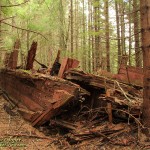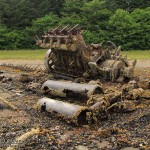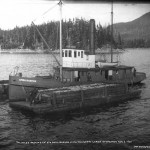It is a quiet place today, a favorite anchorage near Juneau for local sportsman and boaters, rimmed with a dozen homes and cabins. Funter Bay is a convenient place to stop and spend the night for anyone coming into or out of Juneau and Auke Bay. No surprise that we found ourselves using this safe anchorage no less than four times over two weeks. As I have come to find, it is more than a convenient harbor, it is also a very interesting place…
At the beginning of the 20th century, Funter Bay was home to a large cannery and mining operations. Photos from 1900 to 1930 show a bay alive with activity, with substantial buildings supporting the mine and cannery, a post office, church and everything else one would expect in a thriving community. The area has quite a history with tales of industry and tragedy. The stories are a vignette of Alaskan history that typifies the lives of those who came to this place generations ago.
Even with a quick exploration of the area, signs of the past are scattered about to catch an observant eye and inquisitive mind. Pilings on the shoreline, unnatural objects along the beach. Going ashore and poking about soon reveals that the forest conceals even more evidence that this bay looked much different in the past.

On the northern shore of Coot Cove there is the wreckage of a substantial vessel. At low tide a large engine betrays the wreck. On a previous visit I had motored around the engine with our launch, taking a few photographs of a large four cylinder diesel engine protruding from the water. This year was the first time I had had an opportunity to examine the wreckage more closely, low tide had completely exposed the wreck to examination. I could walk where I had previously floated.
Update 25Feb2015: Received an email from a historian at the Alaska Department of Natural Resources. They believe the wreck is the Anna Helen, a tugboat that burned from a gasoline explosion caused by an engine backfire on October 22, 1928.
Update 1May2015: Found a great website by Gabe Emerson who grew up in Funter Bay. He has done some research on the various wrecks, posting the information to his blog. His guess is the tugboat Morzhovoi, an 84 foot diesel vessel owned at one time by the Thlinket Cannery. He also notes that the Anna Baron sank near Swanson Harbor.

Given the winch gear, the large engine and the size of the vessel it is clear that this was some sort of tugboat, equipped to handle barges similar to those found nearby in the woods. She was also extravagantly equipped with electrical gear, several generators, motors and heavy wiring feature among the wreckage. There are also more mundane items, a metal sink and silverware testify to a comfortable existence for the crew. A radiator shows that she was heated, a nice feature in Alaskan waters.
In an attempt to learn more about the tug I did a little research. It did not take long to find more information on Funter Bay. Historical photos in several online archives featured images of the “Thlinket Packing Co.”, with photos of a large cannery and associated fish-traps. “Thlinket” is obviously an alternate spelling used at the time to refer to the local Tlingit people native to the region. Other photos show a Tlingit village in Funter Bay and note that they also worked in the cannery.

Based on the photos I tentatively ID the wreck as the Anna Barron. A vessel of the right size, type and in the correct historical context. If this is the Anna Barron, she lies just across the cove from the barges that she spent decades shuttling to and from the fish-traps along Chatham Strait and Admiralty Island. One has to wonder about her story… How did she end up burned and sunk in the bay? An accident? Deliberately burned when she was too worn to be used or sold?
There is a problem in identifying the wreckage as the Anna Barron… The engine mounted to the hull is produced by a company that was started in 1916, yet the Anna Barron is shown in 1907 photographs. It is possible the engine now in the wreck is not her original engine, but was a refit somewhere during her working life. A refit is not out of the question. A 1907 photo identifiers the Anna as a steamer, typical propulsion for a vessel at the turn of the century. It may have been desirable to refit the tug for diesel with the increased power and reduced maintenance costs offered by the then new technology.
No evidence in hand to prove the case. It may be that the vessel wrecked in Coot Cove is simply some other boat. There is a second candidate, the Barron F., a 75ft cannery tender. Information with this vessel also specifies a different engine, and seventy five feet appears to be somewhat longer than the wreck on the beach.
The barges in the woods are almost certainly those seen in the photographs. They are an exact match in size, shape, construction, including the posts on the decks used to contain the cargo of fish. A reasonable guess is that they were pulled up on the shore for protection from the elements through the winter, ready for next year’s salmon season. A season that never came with the closing of the cannery. They lie forgotten and decaying where they were left.
Funter Bay was gradually abandoned, the mines and cannery closed. The area never becoming a thriving settlement like nearby Juneau or Hoonah. With the land in private hands, is was not added to the holdings of the U.S Forest Service or an Indian corporation. The bay is now dotted with private homes and vacation cabins. As one of the best anchorages near Juneau there are usually a dozen or so boats swaying at anchor each night during the summer season. You have to look a little to see the signs of a rich history, but they are there and fun to explore.

